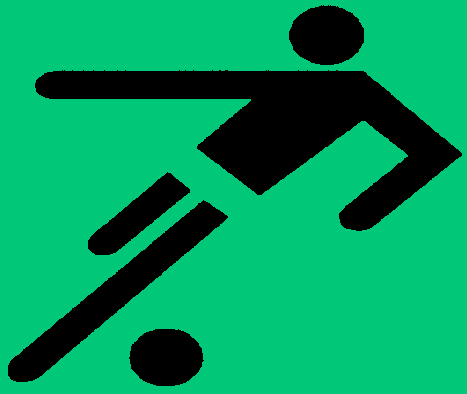GoalGetter
Generation of Spoken Soccer Reports
Welcome to the GoalGetter homepage. The GoalGetter system automatically generates spoken soccer reports in Dutch, on the basis of tabular data about soccer matches played in the Dutch First Division (season 1995/1996).
Unfortunately, we can no longer offer you an on-line demonstration.
Contents
The system
Input
GoalGetter generates Dutch spoken summaries of soccer games, based on information from Teletext. The input to the system is formed by Teletext pages containing tabular information about a specific soccer match. Information about the home team is shown on the left; information about the visiting team is shown on the right. Behind each team name, this team's result is shown. Below it, a list is given of all players who scored a goal for this team. The minute in which a certain player has scored is given between brackets behind the player's name. Own goals and penalties are indicated using a special marker (e.g., /pen indicates a penalty). Then, the name of the referee and the number of spectators are given. Finally, for each team a list is given of all players who received a yellow or red card. An example input table for GoalGetter is shown below.| PSV 1 | AJAX 3 |
| Nilis (90) | Kluivert (5, 18) |
| Blind (83/pen) | |
| Referee: | Spectators: |
| van Dijk | 25.000 |
| Yellow: | |
| Valckx |
Output
GoalGetter generates a spoken summary in three steps. First, the language generation module produces a written text, expressing the information from the input table. Because this text must be pronounced, the text is enriched with markers indicating which words should be accented, and where intonational boundaries (pauses) should occur. Finally, the enriched text is fed into the speech generation module which turns it into a speech signal.An example summary generated by GoalGetter is shown below. It is based on the example input table shown above. The original Dutch text is shown on the left; its English translation on the right. In the text, accents are indicated by bold face, and boundaries of increasing strength by /, // or ///. A version of the text without prosodic markers can be found here.
Click on the following links to hear the
speech
output using either diphone
synthesis or
phrase
concatenation.
(NB: in the diphone version some sentences are missing.)
| De wedstrijd
tussen PSV en Ajax
/ eindigde in een // - drie
///
Vijfentwintig duizend toeschouwers / bezochten het Philips- stadion /// Ajax nam na vijf minuten de leiding / door een treffer van Kluivert /// Dertien minuten later / liet de aanvaller zijn tweede doelpunt aantekenen /// De verdediger Blind verzilverde in de drieentachtigste minuut een strafschop voor Ajax /// Vlak voor het eindsignaal / bepaalde Nilis van PSV de eindstand / op een // - drie /// Scheidsrechter van Dijk / leidde het duel /// Valckx van PSV kreeg een gele kaart /// |
The game between PSV
and
Ajax ended in one - three.
Twenty-five thousand spectators visited the Philips stadium.
Ajax took the lead after five minutes by a goal from Kluivert. Thirteen minutes later the forward had his second goal noted. The defender Blind kicked a penalty home for Ajax in the eighty-third minute. Just before the end signal Nilis from PSV fixed the final score at one - three. Referee van Dijk
officiated
the match. Valckx from
PSV picked up a yellow card.
|
History
GoalGetter is based on D2S, a general architecture for data-to-speech systems developed at IPO, Center for User-System Interaction at the Eindhoven University of Technology. Language generation in D2S is done by means of a hybrid generation technique, in which the use of syntactic templates is guided by linguistic knowledge. Speech generation in D2S can be done in two ways, using either synthesized speech or an advanced form of phrase concatenation.D2S was originally developed as part of the Dial Your Disc (DYD) system, where it was used to generate spoken monologues in English, giving information about recordings of Mozart compositions. Some papers on language generation in DYD are downloadable here. Since then, D2S has also been used for output generation in OVIS, a Dutch spoken dialogue system providing train travel information.
